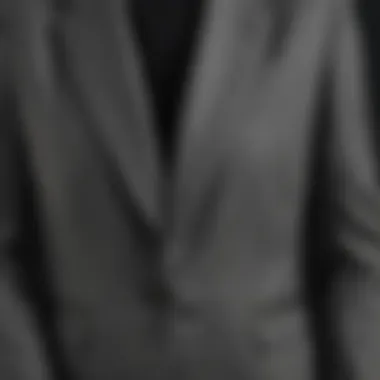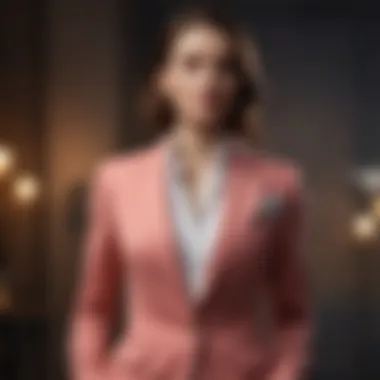The Evolution and Versatility of the Women's Blazer Suit


Intro
The women's blazer suit has become an essential item in modern fashion, transitioning from a purely professional tool to a versatile wardrobe staple. This evolution has mirrored broader societal changes regarding women's roles and identities. Initially introduced in the early 20th century, the blazer suit has adapted to reflect shifting trends in culture and personal expression. The following sections will explore the various facets of this evolution, including its historical significance, styling options, and its impact on self-presentation in both personal and professional contexts.
Fashion Trends and Must-Have Pieces
The appeal of women’s blazer suits goes beyond mere aesthetics; they encapsulate an ideal blend of professionalism and femininity. In recent years, a surge in creativity has marked their evolution.
Runway Reports
Major fashion weeks around the globe have showcased the blazer suit in various interpretations. High-end designers, such as Balenciaga and Chanel, have pushed boundaries, incorporating unexpected materials and silhouettes. These runway reports reveal how the blazer suit has evolved from a traditional fit to more eclectic variations, including oversized styles and vibrant colors.
Street Style Features
On the streets, this garment has been embraced by fashion-forward women of all ages. Influencers often mix and match blazers with casual items like jeans, creating a juxtaposition that feels both laid-back and polished. The versatility of the blazer allows it to be dressed up or down, depending on the occasion. Popular choices include pairing a fitted blazer with a flowy midi dress or layering it over a graphic tee.
Seasonal Must-Haves
Each season brings new trends that refresh the classic blazer suit. In autumn, rich shades such as burgundy and forest green dominate, while spring often welcomes pastel tones and light fabrics. Key pieces to consider include:
- Fitted blazers with unique buttons
- Tailored suits with high-waisted trousers
- Oversized blazers, perfect for layering
- Plaid patterns for a vintage vibe
This adaptability ensures that the blazer suit remains relevant throughout changing seasons.
Accessories That Complement the Blazer Suit
Styling a blazer suit is not only dependent on the cut and fit but also on how it is accessorized. Selecting the right pieces enhances the entire look, providing a polished finish.
Footwear Choices
Footwear can elevate or downplay the sophistication of a blazer suit. For a professional look, classic pumps or ankle boots are ideal. For casual days, sneakers or loafers can create a relaxed vibe.
Jewelry
Minimalist jewelry, such as stud earrings or a delicate watch, pairs well with the sharp lines of a suit. A statement necklace can also work if it’s balanced—too much can distract from the blazer's structure.
Bags and Belts
Opting for structured bags maintains the professional feel, while a belt can help define the waist, especially with oversized blazers. Choosing materials like leather or suede adds a touch of luxury.
Impact on Personal Identity and Professional Attire
The women's blazer suit has not only been a clothing choice but also a powerful statement of personal identity. It conveys ambition and confidence in professional settings, particularly as women occupy more leadership roles. The blazer suit transcends mere fashion; it invites a reconsideration of traditional workwear and its implications on gender roles.
"A well-fitted suit empowers women to project both elegance and professionalism, crucial in the workplace."
Culmination
In summary, the evolution of the women’s blazer suit mirrors broader changes in society. Its versatility, rooted in style and practicality, makes it a must-have for anyone looking to navigate the realms of personal and professional life seamlessly. With various styling options and a rich historical context, they serve not just as fashion pieces but as symbols of empowerment.
Preamble to Women's Blazer Suits
The significance of women’s blazer suits in fashion cannot be understated. These garments not only provide a polished look but also serve as symbols of empowerment and professionalism. Today, the blazer suit is a versatile piece that transcends traditional boundaries, offering a unique blend of style and functionality. As women engage in diverse professional environments, the blazer suit has become essential in creating an impactful first impression.


Women's blazer suits are not merely clothing items; they encapsulate evolving societal norms and expectations. The importance of understanding this topic is multifaceted, revealing insights into how fashion reflects cultural shifts, personal identity, and professional standards. By examining the definition and historical context of this attire, we can appreciate its role in contemporary wardrobes and its effectiveness in various settings.
Definition and Context
A women's blazer suit typically consists of a tailored blazer and matching trousers or skirt. This ensemble is designed to present a more formal appearance compared to casual wear. Blazer suits can be made from various fabrics, including wool, cotton, and blended materials. This combination aims to provide comfort while maintaining a professional appearance.
The blazer itself can vary in style, from a classic fitted look to more relaxed, oversized designs. Hence, it can cater to various personal tastes and occasions, adapting to both traditional and modern aesthetics. It is essential to understand that while this suit can symbolize workplace authority, it also embodies a sense of individuality and fashion awareness.
Historical Overview
The evolution of women's blazer suits reflects broader changes in women's rights and societal roles. In the early 20th century, women began to adopt styles traditionally reserved for men, influenced by significant historical events like World War I. During this time, women took on roles in the workforce, and practical clothing became necessary to support their new responsibilities.
By the 1920s, the introduction of the flapper style marked another pivotal moment. Women started wearing suits with more tailored designs, including the now-iconic blazer. Christian Dior's New Look in the post-World War II era further popularized structured silhouettes in women's fashion, solidifying the blazer suit's role beyond mere functionality to a statement of style.
In recent decades, the blazer suit has continued to evolve. Designers like Giorgio Armani in the 1980s brought a softer approach to tailoring, making it more accessible and stylish. Contemporary designers now introduce innovations with fabrics, colors, and cuts, ensuring that women's blazer suits remain relevant in modern fashion. As such, today's blazer suits represent a combination of rich history and current trends, embodying the spirit of ongoing social change.
The Design Elements of Women's Blazer Suits
The design elements of women's blazer suits play a crucial role in defining their elegance and functionality. Understanding these elements is essential for selecting the right blazer suit that enhances personal style and suits various occasions. Each component—silhouette, fabric, and color—contributes uniquely to the overall appeal. This section will dissect each aspect to highlight their importance in today's fashion context.
Silhouette and Structure
The silhouette of a blazer suit is foundational to its overall impact. It shapes how the suit is perceived and how it fits the wearer. Common silhouettes include slim fit, relaxed fit, and oversized styles.
- Slim Fit: This design creates a form-fitting look, emphasizing the body's natural curves. It is often favored for professional settings where a polished appearance is necessary.
- Relaxed Fit: This style offers comfort without compromising on style. It is versatile, allowing for ease of movement, which is particularly beneficial for all-day wear.
- Oversized Styles: Recently trending, oversized blazers promote a more modern and casual look. They can be styled in various ways, making them suitable for both formal and informal occasions.
Following the silhouette, the structure of the blazer—such as lapel styles, button placements, and pocket designs—adds layers to its functionality. The choice between single-breasted and double-breasted closures can dramatically affect the formality of the outfit. Thus, selecting the right silhouette and structure is pivotal for achieving the desired aesthetic and purpose.
Fabric and Material Choices
The fabric selection significantly influences comfort and durability in women's blazer suits. Various materials provide different vibes and functionalities:
- Wool: A classic choice known for its warmth and structure. Wool blazers maintain their shape and offer a refined look, making them ideal for professional attire.
- Cotton: This fabric is breathable, making it suitable for warmer climates. It often provides a more casual appearance and is easier to care for.
- Blends: Many modern blazers incorporate blends, such as polyester and spandex, offering elasticity and ease. This can enhance the comfort and fit, catering to everyday wear.
Incorporating innovative materials, like sustainable fabrics, also reflects a growing trend towards environmental consciousness in fashion. Such choices not only address practical needs but also resonate with a socially aware consumer base.
Color Palettes and Patterns
Color and patterns are integral in making fashion statements through women's blazer suits. The choice of color can influence how an outfit is perceived.
- Classic Colors: Shades like navy, black, and charcoal are timeless and versatile. They can be styled easily for formal settings, making them staples in many wardrobes.
- Bold Colors and Prints: Bright colors and patterns like plaids or florals can express individuality. These options cater to those looking to make a statement or add flair to their outfit.
- Seasonal Trends: Staying updated with seasonal colors, such as pastels in spring or rich jewel tones in autumn, allows for a fresh take on the blazer suit.
Blending colors and patterns thoughtfully can elevate a blazer suit beyond conventional boundaries, reflecting personal taste while adhering to aesthetic norms.
"The design choices in women's blazer suits are not just about trends; they embody a deeper understanding of personal expression in the complex world of fashion."
In summary, the design elements of women's blazer suits—ranging from silhouette choices to fabric selections and color usage—form the cornerstone of their versatility and relevance in modern fashion. Understanding these components enables one to navigate the wide array of options available today effectively.
Fit and Tailoring for Different Body Types
The fit and tailoring of women's blazer suits are foundational elements that impact how the garment is perceived and worn. Achieving the right fit is crucial for enhancing the wearer's confidence and comfort. This section examines various aspects of fit and tailoring, covering why they matter, key considerations, and guidelines that help in finding the ideal blazer suit for different body types.
Understanding Fit
Understanding what constitutes proper fit is essential in selecting a blazer suit. Fit can influence not only the appearance but also the functionality of the garment. A well-fitted blazer complements the body shape while allowing ease of movement. Key elements of fit include:


- Shoulder Alignment: Shoulders of the blazer should align with the natural shoulder line. Too wide or narrow can distort the overall silhouette.
- Sleeve Length: Sleeves should end right at the wrist bone, allowing the sleeves of any undergarment to show slightly.
- Body Silhouette: The blazer should contour the natural waist without constricting. This ensures the wearer looks polished yet feels comfortable.
Identifying personal body type is the first step. Different body shapes such as apple, pear, hourglass, or rectangle will each require unique considerations to enhance the figure. Adjusting expectations based on one's body type is crucial for a flattering cut.
Tailoring Guidelines
While off-the-rack styles may cater to general tastes, they often require personal adjustments. Custom tailoring enhances the blazer suit's fit and can significantly elevate its appearance. Important tailoring guidelines include:
- Assessing Fit Issues: Common issues include excess fabric around the waist or bust. A tailor can take in the sides for a streamlined look.
- Adjusting Sleeves: Tailoring can lengthen or shorten sleeves to achieve a desired effect, either exposing part of the wrist or covering more of it for modesty.
- Jacket Length: Depending on style preferences and body type, adjusting the jacket's length can help elongate or proportion the look effectively.
A good tailor understands the nuances of body shapes and can provide valuable insights on how to modify a blazer suit for the best fit and style.
Inclusive Sizing
Inclusivity in sizing has gained importance in fashion, acknowledging that women come in varying shapes and sizes. It is crucial for brands to offer a wide range of sizes that cater to diverse body types. Inclusive sizing means:
- Variety of Options: Brands should provide more size options beyond the traditional XS to L, extending into larger sizes without compromising on style.
- Body-Positive Approach: Embracing all body types within marketing materials speaks to real-world representation, making women feel seen and valued.
- Focused Designs: Plus sizes should not merely be scaled-up versions of standard sizes. Instead, they should be thoughtfully designed to accommodate curves and create flattering lines.
This approach not only empowers individuals of all sizes but also enriches the wider fashion landscape. The fashionable blazer suit should be accessible to everyone, ensuring that style does not exclude anyone.
"Fashion is about dressing according to what’s fashionable. Style is more about being yourself." - Oscar de la Renta
In summary, understanding fit, utilizing tailoring guidelines effectively, and advocating for inclusive sizing will ensure that every woman can enjoy the benefits of a well-fitted blazer suit.
Styling a Women's Blazer Suit
Styling a women’s blazer suit is more than just putting on an outfit. It is about expressing one’s personal style while adhering to the context of the occasion. The blazer suit can transform to fit a spectrum of environments, from casual settings to formal events. Understanding how to style a blazer suit allows for versatility and confidence in presentation. This section explores three key elements: casual versus formal looks, layering techniques, and accessorizing for impact.
Casual vs. Formal Looks
Casual outfits can incorporate a blazer suit in a way that feels relaxed yet polished. Consider pairing a tailored blazer with fitted jeans and a simple top. This combination strikes a balance between comfort and style. Footwear choices like ankle boots or stylish sneakers can further enhance the casual feel without sacrificing elegance. Culottes or relaxed trousers with a blazer can also provide an effortless vibe.
In contrast, formal looks elevate the blazer suit for business meetings, formal gatherings, or special occasions. A fitted blazer matched with a tailored skirt or dress pants serves as a strong silhouette for professional settings. Opting for high-quality fabrics such as wool, silk, or crepe lends an additional layer of sophistication. Accessories for formal looks can be kept minimal; a sleek watch or subtle earrings often suffice.
Layering Techniques
Layering with a blazer suit offers excellent opportunities for creative expression. It is essential to consider the climate and occasion when layering. For instance, during colder months, a crisp button-up shirt underneath a blazer adds warmth. Opting for a lightweight turtleneck can provide both style and comfort. Alternatively, a fitted dress worn under a blazer can create a chic and feminine look.
When considering layering, the balance between fitted and loose pieces is crucial. A loose-fitting top under a structured blazer can create a fashionable contrast, as long as it does not overwhelm the silhouette. Additionally, using varying lengths in tops, such as a cropped shirt, can enhance the layers without looking bulky.
Accessorizing for Impact
Accessories play a vital role in enhancing a blazer suit. Select items that complement the outfit without overshadowing it. A statement belt can cinch the waist for a more defined look, and bold jewelry can draw attention, especially in more formal settings. Opting for elegant bags in complementary colors, like a classic tote or a structured purse, reinforces the outfit's overall aesthetic.
Further, the choice of shoes can either align or contrast to create a statement. Heels can elevate a formal outfit, adding sophistication, while stylish flats or loafers can maintain a relaxed vibe. The key is to maintain harmony among the components to ensure a cohesive appearance.
"The right accessories can turn a simple blazer outfit into a powerful statement," emphasizes fashion experts in modern styling.
Understanding how to style a women’s blazer suit can enhance one’s confidence and adaptability in various settings. From casual outings to formal events, the blazer suit serves as a versatile backbone to any wardrobe.
Cultural and Social Impact of Blazer Suits
The cultural and social impact of women's blazer suits is profound and multifaceted. Blazer suits are not merely clothing; they serve as a form of expression and a statement about gender roles in society. This section delves into elements that highlight the significance of blazer suits in contemporary life.
Breaking Gender Norms


Over the years, women's blazer suits have played an essential role in challenging and redefining gender norms. Traditionally, blazers were associated with male attire, symbolizing professionalism and authority. However, as women began to enter the workforce in greater numbers, the blazer suit evolved into a powerful tool for breaking down stereotypes. The adoption of blazer suits helped women assert their presence in male-dominated spaces.
Stereotypical views that equated femininity with fragility began to shift as women donned tailored blazers. The image of a woman in a blazer conveys strength, confidence, and determination.
- Empowerment: The blazer suit empowers women, allowing them to present themselves with authority.
- Visibility: Women in blazers become visible in professional and social circles. This challenges longstanding perceptions about gender roles in these environments.
Professional Identity
The blazer suit has also become a cornerstone of professional identity for many women. In workplaces where dress codes define expectations, wearing a blazer can signify professionalism and competence.
Professionalism is often visually communicated through attire, and women in blazers signal that they are serious about their roles. Additionally, the blazer offers flexibility; it can be styled for various occasions while retaining an air of formality.
Many women report feeling more confident and assertive when dressed in a blazer suit, allowing them to navigate workplace dynamics more effectively.
- Versatile Use: Suitable for various professional settings, the blazer can transition from formal meetings to casual networking events.
- Symbol of Equality: Wearing a blazer emphasizes the idea of equal footing in professional environments, aligning with broader movements for gender equality.
Cultural Representation
The cultural representation of women's blazer suits extends beyond the professional realm. Blazers have been embraced by diverse groups, each infusing their identity into the attire.
In media and popular culture, blazers have been featured prominently, representing both aspirational and relatable narratives. From leading female characters in television to influential public figures, the blazer is often a visual cue for empowerment and independence. This broader representation encourages women to adopt this style, reflecting their personal experiences and identities.
- Influence on Fashion: Designers increasingly incorporate elements that resonate with cultural narratives, making the blazer suit a canvas for expression.
- Symbol of Diversity: The adaptability of blazers across various cultures showcases their universal appeal, resonating with women from different backgrounds.
"The blazer is not just a garment; it's a testament to the evolution of women's roles in society."
In summary, the cultural and social impact of women's blazer suits is significant. Understanding this impact enhances our appreciation for how clothing can influence identity, challenge preconceptions, and empower individuals. As society continues to evolve, so too will the meaning and significance attached to the blazer suit.
Trends Influencing Women's Blazer Suits
The evolution of women's blazer suits goes beyond mere style; it embodies a response to cultural, social, and economic trends that shape contemporary fashion. In today's fast-paced world, factors like sustainability and technological advancements are profoundly impacting how these garments are designed and perceived. This section addresses these trends, focusing on their significance in the realm of women's attire.
Sustainable Fashion Considerations
Sustainable fashion plays a pivotal role in the current fashion landscape. With increasing awareness of environmental issues, many consumers prioritize clothing that is not only stylish but also ethically produced. The rise of sustainable materials, such as organic cotton, Tencel, and recycled polyester, has led to innovative designing processes in women's blazer suits.
These materials reduce the carbon footprint and often entail less water usage during production. Brands like Stella McCartney have pioneered in this space, demonstrating that elegance does not have to come at the expense of environmental responsibility. Consumers today want to align their purchases with their values. This is important because adopting sustainable practices can enhance brand loyalty while also appealing to a demographic that prioritizes eco-consciousness.
"Fashion should be a form of escapism, and not a form of imprisonment." - Alexander McQueen
Furthermore, sustainable practices influence not only the materials but also the lifecycle of the garment itself. The concept of capsule wardrobes, where fewer, high-quality pieces are emphasized, has shifted consumer behavior. The versatility of blazers allows them to serve as foundation pieces, working across multiple styles and occasions, thus enhancing sustainable consumption. Brands are beginning to spotlight sustainability in their marketing efforts, making it a key trend in women's blazer suits.
Tech Innovations in Fabric
Technology is changing the landscape of fashion remarkably. Innovations in fabric technology allow for enhanced functionalities in women's blazer suits. For instance, moisture-wicking and wrinkle-resistant materials are becoming commonplace. These advancements not only improve practicality but also align with today's dynamic lifestyles.
Smart fabrics, which incorporate electronic components, are emerging within the fashion sector. Such innovations create opportunities for responsive clothing, which can adapt to various conditions while maintaining style. This combination of utility and aesthetics appeals strongly to modern consumers, particularly those balancing busy careers and personal lives.
Additionally, advancements in 3D knitting and printing are streamlining production processes, allowing for customized fit and reduced waste. These tech-driven methods align with the needs of consumers seeking both personalized and environmentally friendly options. The fusion of fashion and technology thus sets new benchmarks for functionality and style in blazer suits for women.
Culmination
In summarizing the importance of women's blazer suits, it is evident that they hold a significant place in contemporary fashion. This article has explored various facets of blazer suits, from their historical evolution to their impact on personal identity and social norms. The versatility of the blazer suit allows it to adapt to multiple settings. It serves as a bridge between casual wear and formal attire, making it an essential addition to any woman's wardrobe.
Reflection on the Blazer Suit's Role
Women’s blazer suits have transitioned significantly from their utilitarian origins to become symbols of empowerment and sophistication. In the workplace, a well-fitted blazer can enhance a woman’s professional image. It communicates authority and confidence, qualities that are increasingly demanded in various fields.
Moreover, these suits have entered the realm of cultural expression. Designers have embraced inclusivity, creating styles that accommodate diverse body types and personal preferences. Today, the blazer suit reflects individuality while respecting traditional aesthetic standards. With its growing acceptance, it assists women in navigating the balance between personal style and professional expectations.
Future Outlook in Women's Fashion
The future of women's blazer suits appears promising, amidst shifting attitudes towards fashion sustainability and innovation. There is a noticeable trend toward sustainable fabrics, such as organic cotton and recycled materials. This transition indicates a growing awareness of the environmental impact of clothing production.
Alongside sustainability, advancements in technology offer exciting possibilities for fabric innovation. Smart textiles that adapt to temperature changes or resist stains may soon become commonplace in women's fashion. These developments may further expand the functionality of blazer suits, making them not only stylish but also practical.
In essence, the women's blazer suit represents more than mere clothing. It encapsulates the evolving identity of women in society, bridging tradition and modernity while adapting to changing social contexts.







